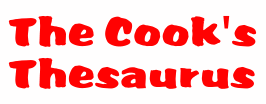|
|
||
 |
||
|
home > meats > cured meats > bacon |
Bacon
|
|
||
 |
||
|
home > meats > cured meats > bacon |
Bacon
![]()
bacon = American bacon = streaky bacon (British) Pronunciation: BAY-kuhn Notes: Bacon is a very fatty slab taken from the underside of a pig. The bacon sold in markets is usually cured and smoked, but it's also possible to buy uncured fresh bacon = pork belly = side pork. Smoked bacon is often fried and served with eggs or in sandwiches, or it's sometimes wrapped around lean meats to keep them moist while they're cooking. Substitutes: turkey bacon (less fat, doesn't shrink as much as regular bacon) OR vegetarian bacon OR imitation bacon bits OR smoked ham OR Canadian bacon (leaner) OR pancetta OR salt pork (in sauces) OR smoked sausage OR ham OR fatback (for barding)
imitation bacon bits Notes: This is soy protein that's flavored to taste like bacon. It's cheaper and lower in fat than real bacon. Substitutes: bacon (Fry bacon until crisp, then crumble into small pieces.) OR nori (Crumble toasted nori sheets over a salad for a healthful alternative to bacon.) OR turkey bacon (crumbled) OR vegetarian bacon (crumbled)
Canadian bacon = back bacon = bacon (British) Notes: Canadian bacon tastes like ham and is much leaner than American bacon. It's made from pork loin that's been smoked and cured. Note that Irish bacon is also sometimes called back bacon. Substitutes: Irish bacon OR ham OR pancetta OR bacon (not as lean)
fatback Notes: This is a slab of fat that runs along the back of a pig. You can render it into lard, cut it into barding strips to wrap around lean roasts, or use it to line terrine or pâté pans. It you're cutting it into sheets, it helps to put it in the freezer first until it's firm. It's also sometimes cured like bacon. It's hard to find, ask your butcher. Substitutes: caul fat (great for making terrines or pâtés, but hard to find) OR bacon (blanch before using; good for barding or lining terrine pans) OR salt pork (blanch first)
gypsy bacon Notes: This Hungarian specialty consists of a slab of bacon that's been roasted and then seasoned with paprika. It's then cut into thin slices and served on rye bread. Look for it in German or Hungarian markets.
Irish bacon = back bacon Notes: This is a lot leaner than American bacon. Note that Canadian bacon also is sometimes called back bacon. Substitutes: Canadian bacon OR pancetta OR regular bacon (consider blanching first to remove smoky flavor)
pancetta = Italian bacon Pronunciation: pan-SHEH-tuh Notes: Pancetta is the Italian counterpart to our bacon. It's cured, but not smoked, and it's often used to give a subtle salty flavor to pasta sauces. Deli counters often carry cylinders of it, and slice it to order. Substitutes: equal parts prosciutto and salt pork OR unsmoked lean bacon OR bacon (Blanch it first in boiling water for a couple of minutes to tone down the smoky flavor.) OR prosciutto
salt pork Notes: This is a salt-cured chunk of fat that comes from pork bellies. It's used in much the same way as bacon, though salt pork is fattier and not smoked. Substitutes: bacon OR ham OR pancetta
vegetarian bacon = tofu bacon = soy bacon Notes: Many meat analogs are disappointing, but some variations on vegetarian bacon are surprisingly tasty. To make your own: See the recipes for Vegan Bacon, Tempeh Bacon, or Tofu Bacon posted on www.vegweb.com. Substitutes: turkey bacon
turkey bacon Notes: Different brands of turkey bacon have wildly different amounts of fat, but most have much less fat than ordinary bacon. The flavor suffers a bit, though. Substitutes: bacon (higher in fat) OR vegetarian bacon
Copyright © 1996 - 2005 Lori Alden